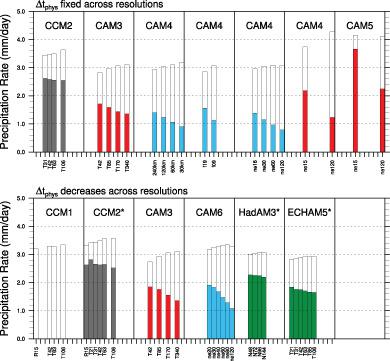当前位置:
X-MOL 学术
›
Q. J. R. Meteorol. Soc.
›
论文详情
Our official English website, www.x-mol.net, welcomes your feedback! (Note: you will need to create a separate account there.)
On resolution sensitivity in the Community Atmosphere Model
Quarterly Journal of the Royal Meteorological Society ( IF 8.9 ) Pub Date : 2020-07-13 , DOI: 10.1002/qj.3873 Adam R. Herrington 1 , Kevin A. Reed 1
Quarterly Journal of the Royal Meteorological Society ( IF 8.9 ) Pub Date : 2020-07-13 , DOI: 10.1002/qj.3873 Adam R. Herrington 1 , Kevin A. Reed 1
Affiliation

|
Advances in high‐performance computing make it possible to run atmospheric general circulation models (AGCMs) over an increasingly wider range of grid resolutions, using either globally uniform or variable‐resolution grids. In principle, this is an exciting opportunity to resolve atmospheric process and scales in a global model and in unprecedented detail, but in practice this grid flexibility is incompatible with the non‐ or weakly converging solutions with increasing horizontal resolution that have long characterized AGCMs. In the the Community Atmosphere Model (CAM), there are robust sensitivities to horizontal resolution that have persisted since the model was first introduced over thirty years ago; the atmosphere progressively dries and becomes less cloudy with resolution, and parametrized deep convective precipitation decreases at the expense of stratiform precipitation. This study documents a convergence experiment using CAM, version 6, and argues that a unifying cause, the sensitivity of resolved dynamical modes to native grid resolution, feeds back into other model components and explains these robust sensitivities to resolution. The increasing magnitudes of resolved vertical velocities with resolution are shown to fit an analytic scaling derived for the equations of motion at hydrostatic scales. This trend in vertical velocities results in an increase in resolved upward moisture fluxes at cloud base, balanced by an increase in stratiform precipitation rates with resolution. Compensating, greater magnitude subsiding motion with resolution has previously been shown to dry out the atmosphere and reduce cloud cover. Here, it is shown that both the increase in condensational heating from stratiform cloud formation and greater subsidence drying contribute to an increase in atmospheric stability with resolution, reducing the activity of parametrized convection. The impact of changing the vertical velocity field with native grid resolution cannot be ignored in any effort to recover convergent solutions in AGCMs, and, in particular, the development of scale‐aware physical parametrizations.
中文翻译:

社区气氛模型中的分辨率敏感性
高性能计算的进步使得使用全球统一或可变分辨率的网格,可以在越来越广泛的网格分辨率范围内运行大气总环流模型(AGCM)。原则上,这是一个激动人心的机会,可以以全局模型和前所未有的细节解决大气过程和尺度问题,但是在实践中,这种网格灵活性与长期以来一直以AGCM为特征的水平分辨率不断提高的非收敛性或弱收敛性解决方案不兼容。在“社区大气模型”(CAM)中,自从30多年前首次引入该模型以来,对水平分辨率就一直存在强烈的敏感性。大气逐渐变干,并且在分辨率下变得更少浑浊,参数化的深对流降水减少,以层状降水为代价。这项研究记录了使用CAM版本6进行的收敛实验,并指出统一的原因,解析的动态模式对本机网格分辨率的敏感性,反馈到其他模型组件中,并解释了这些对分辨率的鲁棒敏感性。解析的垂直速度随着分辨率的增加而增加,显示出适合于静水压力下的运动方程的解析比例。垂直速度的这种趋势导致云层底部解析的向上水分通量增加,而层状降水速率随分辨率增加而平衡。补偿 先前已经证明,具有分辨率的更大的沉降运动会使大气变干并减少云层。在此表明,层状云形成引起的凝结加热的增加和沉陷干燥的增加都有助于大气稳定性和分辨率的提高,从而降低了参数化对流的活动。用原始网格分辨率改变垂直速度场的影响在恢复AGCM中收敛解的任何努力中都不能忽略,尤其是规模感知物理参数化的发展。
更新日期:2020-07-13
中文翻译:

社区气氛模型中的分辨率敏感性
高性能计算的进步使得使用全球统一或可变分辨率的网格,可以在越来越广泛的网格分辨率范围内运行大气总环流模型(AGCM)。原则上,这是一个激动人心的机会,可以以全局模型和前所未有的细节解决大气过程和尺度问题,但是在实践中,这种网格灵活性与长期以来一直以AGCM为特征的水平分辨率不断提高的非收敛性或弱收敛性解决方案不兼容。在“社区大气模型”(CAM)中,自从30多年前首次引入该模型以来,对水平分辨率就一直存在强烈的敏感性。大气逐渐变干,并且在分辨率下变得更少浑浊,参数化的深对流降水减少,以层状降水为代价。这项研究记录了使用CAM版本6进行的收敛实验,并指出统一的原因,解析的动态模式对本机网格分辨率的敏感性,反馈到其他模型组件中,并解释了这些对分辨率的鲁棒敏感性。解析的垂直速度随着分辨率的增加而增加,显示出适合于静水压力下的运动方程的解析比例。垂直速度的这种趋势导致云层底部解析的向上水分通量增加,而层状降水速率随分辨率增加而平衡。补偿 先前已经证明,具有分辨率的更大的沉降运动会使大气变干并减少云层。在此表明,层状云形成引起的凝结加热的增加和沉陷干燥的增加都有助于大气稳定性和分辨率的提高,从而降低了参数化对流的活动。用原始网格分辨率改变垂直速度场的影响在恢复AGCM中收敛解的任何努力中都不能忽略,尤其是规模感知物理参数化的发展。



























 京公网安备 11010802027423号
京公网安备 11010802027423号